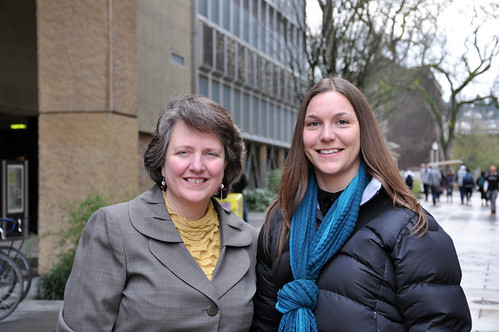On March 3rd, Deputy Agriculture Secretary Kathleen Merrigan gave an informative speech about USDA’s ‘Know Your Farmer, Know Your Food’ initiative to a packed crowd of Portland State University (PSU) students and faculty. As both a PSU graduate student of Public Administration and a new employee with USDA Rural Development in Oregon, I was impressed by USDA’s active role in creating solutions to some of our most pressing national and global issues.
After hearing her speak, I find myself not only motivated by the Department of Agriculture’s efforts, but also encouraged that the Obama Administration has recruited a Deputy Secretary who clearly has extensive expertise, including an educational foundation in science, as well as an obvious commitment to finding solutions for the agricultural issues our nation faces.
Deputy Merrigan began her talk by emphasizing to students that no matter what their interests, there is a relevant connection to be made in addressing the challenges of their generation.
As she spoke about the food system in the United States, it was clear that improvements and innovation are vital in order to address national trends, such as childhood obesity and increased rates of diabetes. Deputy Secretary Merrigan also emphasized trends in the agricultural sector and American farmers, who account for less than 2 percent of our population today. With one American farmer feeding 155 people today, it is alarming to consider the rate of those leaving agriculture without a new generation coming in to fill their shoes.
The presentation highlighted efforts by the USDA to combat these trends through areas such as natural resource conservation, production, aggregation, processing and distribution, marketing, consumption and waste management. The Deputy provided snapshots of some of these USDA efforts, including:
- Nutrition assistance helping 1 in 7 Americans purchase healthy food while making ends meet every month;
- Cost-share for hoop-houses and other conservation practices that improve agricultural production while protecting soil, water and other natural resources;
- Crop insurance to protect American farmers from drought and other natural forces that compromise their economic stability;
- Various loan and grant programs for new and seasoned farmers to preserve the future of family farms, make farming a viable economic endeavor and promote the health of rural communities; and
- USDA’s support for the development of local and regional food hubs to bridge the gap between local farmers and consumers, market local foods, improve local economies, and ensure a supply of fresh, nutritious foods to American communities;
The food hub concept, along with USDA’s many other programs, aligns with the ‘Know Your Farmer, Know Your Food’ initiative by further encouraging Americans to connect with local farmers and buy locally produced food. The incentive for buying local was made obvious when Deputy Secretary Merrigan explained that only 19 cents of every food dollar in America goes directly to the farmer. Buying local not only puts more of each food dollar into our farmers’ pockets, but it ensures that more of the money consumers spend will remain in their local community. In fact, buying local can keep $73 out of every $100 spent in the local economy, as compared to only $43 for non-local purchases.
As a new employee to USDA Rural Development and a native Montanan with family currently farming in Hysham, I am grateful to be a part of an agency that is focusing so much energy on improving the conditions of American farmers and rural communities. As an individual aspiring for a career in public administration, I am incredibly encouraged to see such efforts to improve the livelihoods of so many Americans that, at the same time, contribute to solutions to our global challenges.

